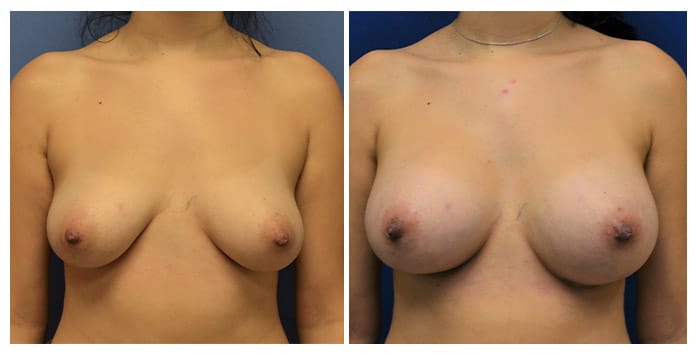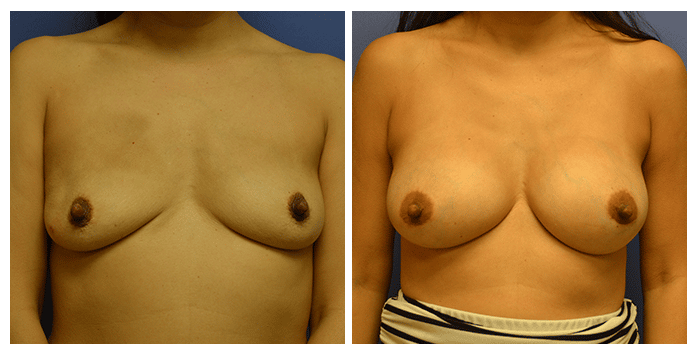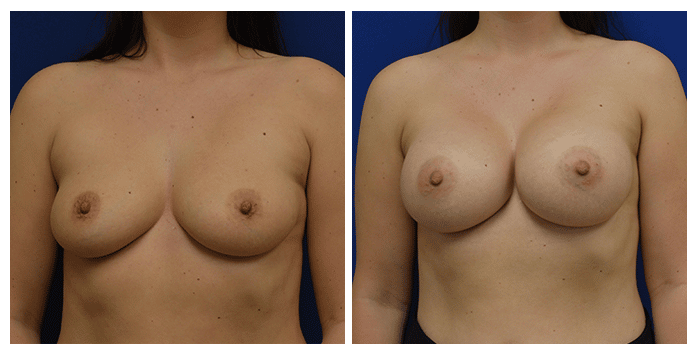Breast Augmentationin Portland, Oregon
Quick Links ‹
- WHAT IS BREAST AUGMENTATION?
- WHO IS A CANDIDATE FOR BREAST IMPLANT SURGERY?
- BREAST AUGMENTATION CONSIDERATIONS
- Types of Implants for Breast Augmentation
- Alternatives to Breast Augmentation
- What To Expect During The Consultation
- The Breast Augmentation Procedure
- THE RAPID RECOVERY PROCEDURE
- RESULTS AND RECOVERY
- What are the Risks of Breast Augmentation?
- BREAST AUGMENTATION IN PORTLAND, OREGON
- BREAST AUGMENTATION FAQS
WHAT IS BREAST AUGMENTATION?
Breast augmentation is a popular cosmetic surgery procedure performed to increase the size of the breasts using breast implants or fat grafts. This treatment can help people enhance their breast volume or restore a natural-looking breast shape to their figures.
WHO IS A CANDIDATE FOR BREAST IMPLANT SURGERY?
Breast augmentations remain one of the most popular cosmetic surgeries from year to year. People in and around Portland, Oregon consider this procedure for a variety of reasons, such as:
- You feel that your breasts are too small for your body type
- You feel uncomfortable wearing a swimsuit or low-cut tops because of your breast size
- You have small or deflated breasts due to weight loss
- You have asymmetrical breasts

If you experience one or more of the above concerns, you may be able to benefit from breast augmentation or a related procedure, such as a breast lift. Breast augmentation patients need to be in generally good health and have reasonable expectations and motivations for wanting to increase their breast size. Dr. Fichadia will also tell patients to stop smoking before the plastic surgery procedure, as this limits the body’s ability to heal.
At the end of the day, an in-office consultation with board-certified plastic surgeon Dr. Hetal Fichadia is the best way to determine if you’re a good candidate to be a breast augmentation candidate.
Before & After
Sensitive Content
Click to view only if you are 18 or older

Breast Augmentation Case 9
Sensitive Content
Click to view only if you are 18 or older

Breast Augmentation Case 1
Sensitive Content
Click to view only if you are 18 or older

Breast Augmentation Case 2


BREAST AUGMENTATION CONSIDERATIONS
Breast augmentation comes with a few different choices that will determine the path of your surgery and the outcome of your results. These include your breast implant type, your incision, and the implant’s placement.
BREAST IMPLANTS
The broader classifications of breast implants are silicone gel implants and saline breast implants (both types are generally made with a silicone shell). Both saline and silicone implants Dr. Fichadia uses are FDA-approved, and breast implants, in general, are some of the most widely studied and documented medical devices in history.
Saline implants are filled with a sterile saltwater solution after placement inside the breasts, and the advantage of these implants is that it requires a smaller incision that is easy to conceal within the breast’s natural folds and pigmentation. The downside is that it is liable to deflate the breast if it ruptures, but this makes it easy to detect.
The other types of breast implants are filled with silicone gel. Their advantage is that they are softer and give a more natural look and feel compared to saline implants. Since they do not deflate with a rupture, however, this type can require an MRI scan to detect any weak areas or tears. “Gummy bear” implants are silicone implants but are filled with a more cohesive silicone gel, which is more like a solid than liquid, giving it a “gummy bear” consistency that feels very similar to natural breast tissue.
Additionally, both saline and silicone breast implants come in many different shapes and sizes, meaning Dr. Fichadia can assist you with selecting the ideal implant for your exact results. Some factors include projection, profile, shape (round or teardrop-shaped), and texture, all of which will produce different results.
It’s important for a woman to know exactly how they would like their results to appear so that choosing the type of implant becomes easier.
INCISIONS
There are also a number of incision patterns that can be used for breast surgery. Dr. Fichadia offers breast augmentation techniques using these incision options:
- Inframammary incision, which follows the curve of the natural breast fold.
- Periareolar incision, which follows the pigmentation of the areolae.
Each of these incisions offers different benefits, depending on your implant choice and intended results. Both offer effective concealment for scarring, but you can speak with Dr. Fichadia about your options if your skin is especially prone to scarring.

IMPLANT PLACEMENT
Implants can be placed in one of two ways during a breast augmentation procedure: underneath the pectoral muscle or above it. In either case, a small pocket is formed within the breast tissue to accommodate the breast implant.
Each placement type offers different benefits and will provide a different feel, comfort, and projection. During your consultation, Dr. Fichadia will discuss your best options for all the various breast augmentation procedures, including implant size, shape, and placement.
Subglandular Placement: Subglandular placement involves placing the implant above the pectoral muscle and beneath the breast glandular tissue. Implants placed in this position typically provide more pronounced projection, enhancing the overall size and shape of the breasts.
The procedure is generally less complex and has a shorter recovery time, and it is also easier to adjust the position of the implants and correct any issues that may arise. Patients often experience less postoperative pain and discomfort than submuscular placement.
Submuscular Placement: Submuscular placement involves positioning the implant underneath the pectoral muscle. Implants placed under the muscle tend to look and feel more natural as the muscle provides an additional layer of coverage.
Women with thinner breast tissue are also less likely to experience visible rippling, and the risk of capsular contracture is reduced because the implant is better protected by the muscle. Furthermore, this placement allows for more accurate mammogram readings, as the implant is not in the way.
During your consultation, Dr. Fichadia will discuss your best options for all the various breast augmentation procedures, including implant size, shape, and placement.

Types of Implants for Breast Augmentation
When considering breast augmentation, it’s essential to understand the different types of implants available to achieve the desired look and feel:
- Saline Implants: Implants are inserted empty and then filled with sterile salt water once in place, allowing for a smaller incision during surgery.
- Silicone Implants: These implants are pre-filled with silicone gel and come in various sizes and shapes.
- Gummy Bear Implants: Also known as form-stable or highly cohesive silicone gel implants, these implants maintain their shape even if the implant shell is broken.
- Fat Transfer: Fat transfer breast augmentation involves using liposuction to take fat from other parts of your body, such as the abdomen or thighs, and injecting it into the breasts.
Silicone Shell Types for Implants
Silicone shell implants come in different shapes and textures, each offering unique benefits; by understanding their specific characteristics, you can make an informed decision that aligns with your aesthetic goals and lifestyle:
Round Breast Implants
Round breast implants are the most common type and provide a fuller appearance compared to teardrop-shaped implants. They are symmetrical and can make the breasts appear more voluminous. Round implants are less likely to rotate out of place, consistently maintaining the desired breast shape.
Smooth Breast Implants
Smooth breast implants have a sleek, soft outer shell that allows them to move freely within the breast pocket, mimicking the natural movement of breast tissue. They are less likely to cause rippling under the skin and often feel softer to the touch compared to textured implants. Smooth implants are typically used for patients seeking a more natural look and feel.
![]()
Alternatives to Breast Augmentation
Breast augmentation is popular for enhancing breast size and shape, but it’s not the only option available. Alternatives to breast augmentation might be more suitable depending on your goals and body type:
Breast Lift (Mastopexy)
A breast lift raises and firms the breasts by removing excess skin and tightening the surrounding tissue. While it doesn’t significantly change the size of the breasts, it can enhance their shape and position.
Breast Reduction
For those who feel their breasts are too large and may be causing physical discomfort, a breast reduction can be a great alternative. It can also alleviate discomfort associated with overly large breasts, such as back and neck pain.
Fat Transfer Breast Augmentation
Fat transfer breast augmentation uses liposuction to harvest fat from other areas of the body and inject it into the breast, providing a natural enhancement without the use of implants.
What To Expect During The Consultation
During this initial meeting, Dr. Fichadia will ask about your desired breast size and shape, any concerns you have, and what you hope to achieve with the procedure. He will then perform a physical examination to assess your breast anatomy, skin quality, and body type, taking measurements to help plan the surgery.
You will learn about the different types of implants and their various shapes and textures; Dr. Fichadia will help you choose the best option for your body and aesthetic goals. This is also your opportunity to ask any questions you may have about the procedure, recovery, and potential risks. Dr. Fichadia will provide clear, thorough answers to ensure you feel confident moving forward.

The Breast Augmentation Procedure
The breast augmentation procedure typically begins with the administration of anesthesia to ensure your comfort, and an incision is then made in an inconspicuous area to minimize visible scarring. Common incision sites include the inframammary fold (under the breast), periareolar (around the nipple), and transaxillary (under the arm).
After the incision is made, a pocket is created either under the pectoral muscle (submuscular placement) or over the pectoral muscle (subglandular placement), and the chosen implant is inserted into this pocket. The incisions are then closed with layered sutures in the breast tissue, and sutures, skin adhesive, or surgical tape is used to close the skin.
THE RAPID RECOVERY PROCEDURE
Dr. Fichadia prefers to practice a set of techniques called rapid recovery breast augmentation, which leads to excellent results without the extended recovery period of traditional breast augmentation Portland. This surgical breast implant procedure includes taking care at every step of the procedure to avoid tissue aggravation and rough handling, both of which contribute to swelling and the risk of complications like capsular contracture. In practice, here is what rapid recovery breast augmentation looks like.
PRE-OPERATIVE STEPS
This process starts at your consultation with the precise and complete measurement of the treatment area, implants, and incisions. Although this is done at any breast augmentation consultation, the rapid recovery technique does it with the intent of reducing as much trauma and manipulation to the surrounding tissues as possible. When Dr. Fichadia has exact measurements and can precisely plan her technique, she can avoid these things that commonly contribute to extended recovery periods.
INTRAOPERATIVE STEPS
Most patients are surprised to learn that the rapid recovery method avoids using any deep anesthetic, intubation, or ventilation, and can be performed with a combination of lighter anesthetics. This greatly reduces any nausea or adjustment period after the surgery is complete, meaning many patients can be mobile after their procedure. The surgical techniques also focus on reducing bleeding, tissue trauma, and time spent in the operating room. Another factor that greatly reduces downtime is avoiding contact with the breast implant, which also greatly reduces the chance of infection.
POST-OPERATIVE STEPS
Post-operative care is crucial to ensure a smooth recovery and optimal results from your breast augmentation. Your first follow-up visit will typically be within a few days to a week after surgery to check your incisions and ensure you are healing properly.
Dr. Fichadia will schedule additional follow-ups at regular intervals to monitor your progress, including the implants and breast tissue. For patients with silicone breast implants, it is recommended to have MRI or ultrasound screenings starting 5 to 6 years after surgery and every 2 to 3 years thereafter to check for silent ruptures. Dr. Fichadia and her team are always available to address any questions or concerns that may arise during your recovery and beyond.
RESULTS AND RECOVERY
You will receive detailed instructions for your rapid recovery during your consultation with Dr. Fichadia, but generally, you can expect to take two to three days off of work or school. After your breast augmentation surgery, you will be placed in a surgical bra to help minimize swelling and support your new breast size and shape as you heal.
Mild swelling, discoloration, tightness, and discomfort are expected. Excessive physical activity should be avoided for the first two weeks, though light walking is recommended. While most of the physical and emotional recovery occurs within 1-2 weeks after surgery, the recovery of the augmented breasts to their final appearance usually takes several months. Dr. Fichadia will schedule post-surgical appointments with you to help monitor your breast augmentation recovery.

What are the Risks of Breast Augmentation?
While breast augmentation is generally safe, it is important to be aware of potential risks and complications, which include:
- Infection: To minimize this risk, it is crucial to follow post-operative care instructions.
- Capsular Contracture: When the scar tissue around the implant hardens, potentially causing discomfort and altering the shape of the breast.
- Implant Rupture or Leakage: Regular monitoring through MRI or ultrasound is recommended to ensure the implants remain intact.
- Changes in Sensation: Some patients may experience changes in nipple or breast sensation, which can be temporary or permanent.
- Anesthesia Risks: Including adverse reactions to anesthesia in or post-operation.
BREAST AUGMENTATION IN PORTLAND, OREGON
If you want to boost your self-confidence by looking great in whatever you choose to wear, breast augmentation may be right for you. We know you have many breast augmentation choices and we’re ready to show you why Dr. Hetal Fichadia is the best choice for your plastic surgery. Please contact our office today by calling (503) 488-2344 or contact us online to schedule your consultation with Portland breast augmentation surgeon Dr. Fichadia.
BREAST AUGMENTATION FAQS
Are breast implants under warranty?
Yes. Most manufacturers cover their implants under warranty. They differ in their duration, coverage, and extra fees. Each of these manufacturers warranties is very strong. All of them provide a level of coverage and protection that is unusual in any product, particularly one that receives as much wear-and-tear as a breast implant. We do not recommend choosing an implant brand based on warranty alone. The breast implant brand used for your surgery should be discussed in detail with Dr. Fichadia and ought to be based on a variety of factors.
How long is breast augmentation recovery?
Dr. Fichadia uses innovative techniques to make breast augmentation a rapid recovery procedure. The patients should be able to go out the same evening. The soreness in the muscle feels more like it feels after an intense work out. Patients can expect to take up to three days off work or school. Any physical or strenuous activity should be avoided for two weeks post-op, at which point all activities can be resumed. The optimal results from breast augmentation will still not be apparent for a few months as the tissues heal.
What happens if you do not massage your breast implants?
Some patients have heard that massaging your breasts after breast augmentation is good for preventing capsular contracture, but this is unproven in the literature. In the initial healing period, massaging the breasts can do more harm than good. After surgery, you will be fitted with a surgical bra or compression garment to aid in healing and making sure the implants settle into the desired position. Once healing process is over, implant massage can be done, but there is no clear cut evidence that this helps prevent capsular contracture.
What causes breast implants to rupture?
All breast implants have a chance of rupturing. Over time, the risks of implant rupture increases. Most implant rupture is caused due to aging of the implant, but rarely, it can also be caused by trauma from accidents or impact to the breasts.
What is a gummy bear implant?
A gummy bear implant is one of the many implant options available for breast augmentation. these implants are silicone gel breast implants that contain a more form-stable material. They are called gummy bear implants because they are known to retain their shape better than other types of implants while still allowing breasts to still be naturally soft.
Do breasts sag after breast augmentation?
Breast implants can sag over time, especially if they are large. The augmentation surgery does not stop the skin from aging so the natural strength and skin elasticity of the breasts can change, to causing the implants to sag.
Can breast implants cause pain years later?
Yes. Breast implants can cause pain either due to capsular contracture (where the shell around the implant gets thickened and tight) or leakage (which may or may not always be painful).
Can breast implants last 30 years?
Yes, they can, but it is more an exception than the rule. Breast implants can have weakness in their outer shell 10-20 years after placement, causing leakage. It may not always be visually apparent through breast shape. For patients, it is important to understand that breast implants will likely need additional surgeries in the future for replacement or removal or revision.
Can fat be transferred to breasts?
Yes!! Fat transfer is a great way for all-natural breast augmentation, with the added benefit of contouring a different area of your body. It is one of Dr Fichadias clinical interests as well.
Will Cigna cover breast augmentation?
Cosmetic breast augmentation is not covered by insurance.
Whats the safest breast implant?
All the currently available breast implants have undergone rigorous testing and found to be safe. That being said, it is important to understand that they are not meant to be lifetime devices, and will need replacement in the future. For silicone breast implants, FDA recommends screening for silent rupture by an MRI starting 5-6 years after placement and every 2-3 years thereafter.
What are gummy bear implant?
A gummy bear implant is one of the many implant options available for breast augmentation. these implants are silicone gel breast implants that contain a more form-stable material. They are called gummy bear implants because they are known to retain their shape better than other types of implants while still allowing breasts to still be naturally soft.
How long are breast augmentation incisions sore?
Breast augmentation incisions can be sore for upto 1-2 weeks. Most patients dont need any strong opioid-type pain medications after the surgery.
How do you know if you have capsular contracture?
If the breast starts to feel firm and/or tight, that may be a sign of early capsular contracture.
Can you breast feed after breast augmentation
Yes! You can breast feed after breast augmentation, especially if the incision is made in the breast fold at the bottom of the breast, which is what Dr Fichadia recommends. It is important to know that a certain percentage of women may have trouble with breastfeeding regardless of whether they have implants placed or not.
Can I move my arms after breast augmentation?
Yes! Dr Fichadia encourages arm movement after breast augmentation to promote speedy recovery. In fact, you will start doing arm stretches in the recovery area itself!
Does getting breast implants make you gain weight?
There is no clear scientific evidence linking breast implants with weight gain.
Do breast implants cause autoimmune disease?
At this point, there is no strong scientific evidence suggesting a direct link between breast implants and autoimmune diseases.
Do you have to replace breast implants every 10 years?
Breast implants are not meant to be lifetime devices and will likely need replacement in the future. This time is variable, but usually between 10-15 years. If your breasts look good, and imaging shows no rupture, there is no reason to replace the implants immediately. In general, the longer the implants have been in place, the more likely it is to find a rupture.
How do I know if my breast implant is leaking?
With saline filled breast implants, a leakage will result in visible loss of volume of the breasts. With silicone breast implants, there can be a rupture without any obvious visible changes to the breast. An MRI or high resolution ultrasound can be helpful to evaluate if the implant is ruptured.
Does insurance cover breast implants?
Insurance covers placement of breast implants only after a mastectomy (removal of breast tissue) for breast cancer treatment or prevention. Insurance does not cover cosmetic breast implant placement.
How dangerous is breast augmentation surgery?
A breast augmentation surgery is takes 1-1.5 hours under general anesthesia, and is extremely safe. It is an outpatient surgery with return to daily low impact activities within 2-3 days.
Is breast enlargement possible without surgery?
There is no way to enlarge breast tissue without surgery.
What are cohesive breast implants?
A cohesive breast implant has cross linked silicone which reduces the risk of rippling and implant rupture.
How painful is breast augmentation recovery?
Dr Fichadia uses rapid recovery technique for breast augmentation using breast implants. It is an outpatient surgery, and patients return to their daily activities within 2-3 days. Most patients dont require anything more than Tylenol and anti inflammatory pain medications. It is important to follow all the instructions and post surgery stretches to ensure smooth recovery.
Is there an alternative to breast implants?
Fat grafting is an alternative way to enhance the size and shape of the breast tissue. Dr Fichadia harvests unwanted fat from other areas through liposuction and injects it into the breast tissue for permanent breast enlargement.
Is getting a breast augmentation worth it?
Breast augmentation is one of the surgeries with a very high patient satisfaction rate.
What is the difference between a breast augmentation and breast implants?
A breast augmentation is an enlargement in breast size, most commonly done using breast implants. It can also be done using fat grafting to the breast.
What is the average cost of a breast augmentation?
Average cost of a breast augmentation (using silicone breast implants) with Dr Fichadia is $7200- $7900
What are Natrelle breast implants?
Natrelle is a line of breast implants made by Allergan
What can go wrong with breast implants?
Breast implants can rupture, go out of position, and develop tightness of surrounding scar tissue (capsular contracture)
how much does breast augmentation cost?
Average cost of a breast augmentation (using silicone breast implants) with Dr Fichadia is $7200- $7900
What is the most common breast implant size?
Dr Fichadia recommends a breast implant based on your chest measurements and size goals for bespoke results, therefore, there is no one size that fits most of our patients.
Dr. Fichadia is a double board-certified, comprehensively trained plastic and reconstructive surgeon. She completed general surgical training at St Elizabeth’s Medical Center, an affiliate of Tufts University School of Medicine in Boston, MA, and subsequently completed a highly competitive plastic surgery program at Oregon Health and Science University in Portland, OR. She has presented research from her time in Boston and Portland at national and international surgical meetings such as Clinical Congress of the American College of Surgeons and annual meeting of American Society of Plastic Surgery.
- Dr. Hetal Fichadiahttps://www.drfichadia.com/author/admin/
- Dr. Hetal Fichadiahttps://www.drfichadia.com/author/admin/
- Dr. Hetal Fichadiahttps://www.drfichadia.com/author/admin/
- Dr. Hetal Fichadiahttps://www.drfichadia.com/author/admin/
 (503) 488-2344
(503) 488-2344






